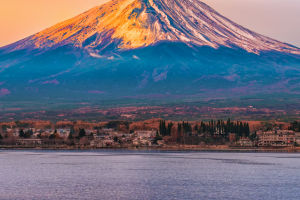The sunset glow is formed when light from the sun interacts with the air.
As sunlight enters the atmosphere, it encounters molecules and particles suspended in the air, leading to a process called scattering.
These atmospheric molecules and particles themselves do not emit light, but they scatter the sun's light, creating multiple sources of scattered light throughout the atmosphere.
According to the law of Rayleigh scattering, shorter wavelengths of light, such as violet, blue, and cyan, are more easily scattered, while longer wavelengths, like red, orange, and yellow, have stronger transmission abilities.
As a result, we observe that the clear sky appears azure blue, and only the longer wavelengths of light, such as yellow, orange, and red, are left over the horizon.
These rays of light are scattered by air molecules and impurities like water vapor, giving the sky its brilliant colors during sunset.
A vivid red sunglow in the morning indicates the presence of numerous water droplets in the atmosphere, suggesting that rainy weather may be approaching.
Conversely, a fiery red or golden yellow sunset glow signifies a lack of clouds in the western sky for the sunlight to penetrate, indicating sunny weather ahead. Colorful clouds occasionally appear in the sky around sunrise and sunset.
Haze occurs when sunlight passes through the dense atmosphere and scatters among a large number of air molecules, especially during sunrise and sunset.
The amount of dust, water vapor, and other impurities in the air determines the intensity of the colors observed. When there is cloud cover, the clouds themselves can take on a vibrant orange-red hue.
The reason why the sunset glow appears red is due to the scattering of sunlight. Shorter wavelengths of light, such as purple, green, and blue, are more easily scattered, resulting in a transparent azure sky during clear weather.
On the other hand, longer wavelengths of light, including red, orange, and yellow, have better transmission abilities, which explains the warm orange haze often seen above the horizon. This scattering phenomenon also contributes to the striking colors witnessed during sunrise and sunset.
During early mornings or evenings when the sun is low, the clouds in the sky often exhibit a reddish hue resembling fire. These reddish clouds are commonly referred to as burning clouds or morning and evening sunsets glow.
Occasionally, when there are no clouds present, the sky itself can take on a fiery red color, which is also known as the fire cloud.
Fire clouds are low-level clouds that appear reddish in color during sunrise or sunset. They are a natural occurrence related to atmospheric changes. These clouds are frequently seen in the western sky during summer, particularly after a thunderstorm.
The shape of fire clouds varies significantly due to strong ground evaporation and the influence of updrafts in the atmosphere. Typically, the color of these clouds is reddish, and their appearance suggests the approach of warm weather, abundant rainfall, and thriving biological growth.


